Tire Size 175/65r14 vs 185/60r14
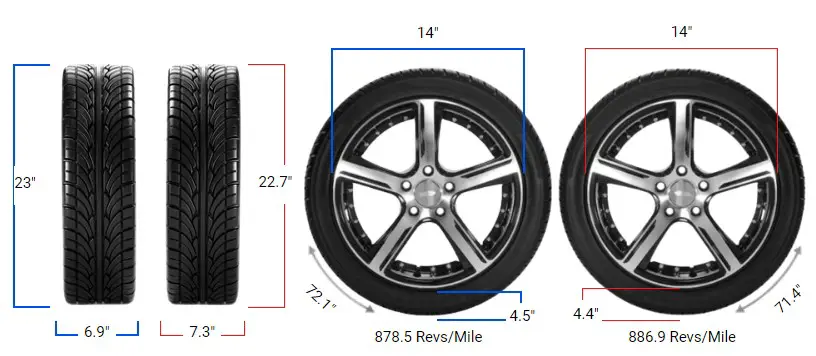
Tire upgrades can enhance your vehicle’s performance and look. Let’s explore the switch from 175/65r14 to 185/60r14 tires, examining the impacts on your ride both on and off the road.
- The new tires are 5.7% wider, improving grip and stability.
- Overall diameter decreases by 0.9%, within the safe 3% range.
- Sidewall height reduces by 2.4%, potentially affecting ride comfort.
- Speedometer accuracy changes slightly, showing 0.19 mph slower at 20 mph.
175/65r14 vs 185/60r14 Table
Switching from 175/65r14 to 185/60r14 tires is generally considered safe and within acceptable limits.
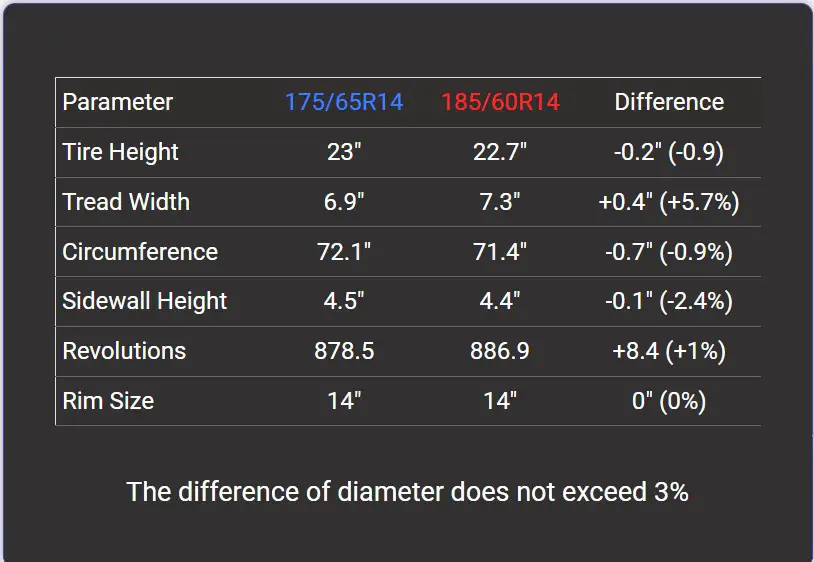
Fitment Guide
The diameter difference between the 175/65r14 and 185/60r14 tires is -0.9%, well within the acceptable 3% range. This means the interchange is recommended and safe for your vehicle. You won’t need to make any significant adaptations to prevent rubbing or clearance issues.
On-Road Impact
On the road, the switch to 185/60r14 tires can bring noticeable changes to your driving experience. Let’s break down the key areas affected:
- Handling: The wider 185/60r14 tires offer improved grip and stability. With an extra 0.39 inches (10 mm) of width, these tires provide a larger contact patch with the road. This can result in better cornering ability and more confident handling, especially during quick maneuvers or in wet conditions.
- Ride Comfort: The lower profile of the 185/60r14 tires might slightly reduce ride comfort. With 0.11 inches (2.75 mm) less sidewall height, these tires have less rubber to absorb road imperfections. You may feel bumps and road texture more distinctly, but the difference is likely to be minimal for most drivers.
- Speedometer Accuracy: The slight decrease in overall diameter affects your speedometer readings. At 20 mph, your actual speed will be about 19.81 mph. This 0.19 mph difference is negligible in most situations but worth noting for precise speed control.
- Gas Mileage: The minor change in tire size is unlikely to have a significant impact on fuel efficiency. Any differences would be minimal and likely overshadowed by other factors like driving style and road conditions.
- Aesthetics: The wider, lower-profile 185/60r14 tires can give your vehicle a sportier, more aggressive look. This subtle change might enhance the overall appearance of your car, especially if you prefer a more performance-oriented style.
Off-Road Impact
While the switch primarily affects on-road performance, there are some considerations for off-road use:
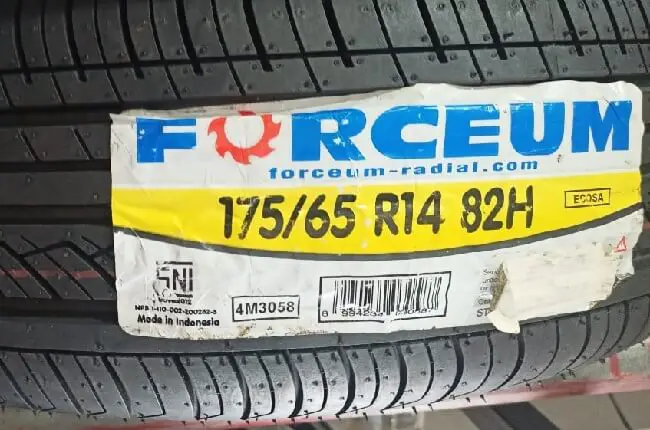
- Ground Clearance: The 0.22-inch (5.5 mm) reduction in overall diameter translates to a very slight decrease in ground clearance. For most off-road situations, this minimal change won’t significantly impact your vehicle’s ability to navigate rough terrain.
- Traction: The wider tires may provide better traction on some off-road surfaces, particularly in mud or loose soil. However, the lower profile could make the tires more susceptible to damage from rocks or other sharp objects.
- Durability: The lower profile of the 185/60r14 tires might make them slightly more vulnerable to damage from off-road hazards. However, the difference is minimal, and proper driving techniques can mitigate any increased risk.
What is the Difference Between 175/65r14 and 185/60r14?
The main difference between 175/65r14 and 185/60r14 tires lies in their width and profile. The 185/60r14 tire is 0.39 inches (10 mm) wider than the 175/65r14, offering a 5.7% increase in width.
This wider footprint can improve grip and stability on the road. However, the 185/60r14 has a lower profile, with a sidewall height 0.11 inches (2.75 mm) shorter than the 175/65r14.
This combination of increased width and lower profile results in a slightly sportier look and potentially enhanced handling characteristics, while maintaining a similar overall diameter.
Can I Use 175/65r14 Instead of 185/60r14?
Yes, you can use 175/65r14 instead of 185/60r14 tires. The overall diameter difference between these two tire sizes is only -0.9%, which is well within the recommended 3% range for safe tire interchange.
This small difference means that switching between these sizes shouldn’t cause any significant issues with fitment, speedometer accuracy, or vehicle performance.
However, you may notice slight changes in handling and ride characteristics due to the differences in width and sidewall height.
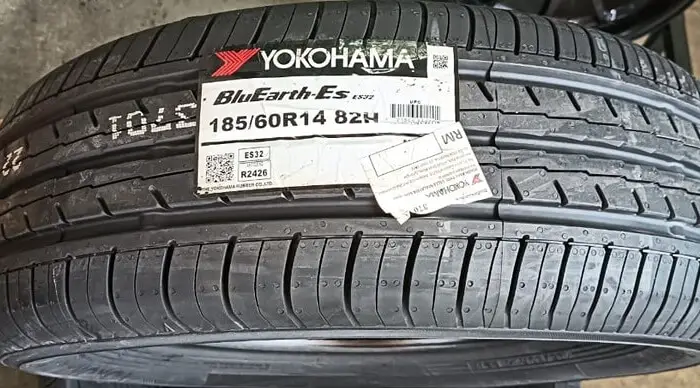
How Much Taller Is A 175/65r14 Tire Than A 185/60r14?
The 175/65r14 tire is slightly taller than the 185/60r14 tire. The difference in overall diameter is 0.22 inches (5.5 mm), with the 175/65r14 being taller. This represents a 0.9% increase in height for the 175/65r14 tire compared to the 185/60r14.
While this difference is noticeable when comparing the tires side by side, it’s small enough not to cause significant issues when interchanging these tire sizes on a vehicle.
How Much Wider is a 185/60r14 Tire Than a 175/65r14?
A 185/60r14 tire is 0.39 inches (10 mm) wider than a 175/65r14 tire. This represents a 5.7% increase in width. The 185/60r14 has a width of 7.28 inches (185 mm), while the 175/65r14 has a width of 6.89 inches (175 mm).
This increased width provides a larger contact patch with the road, which can contribute to improved traction and handling characteristics, especially during cornering or in wet conditions.
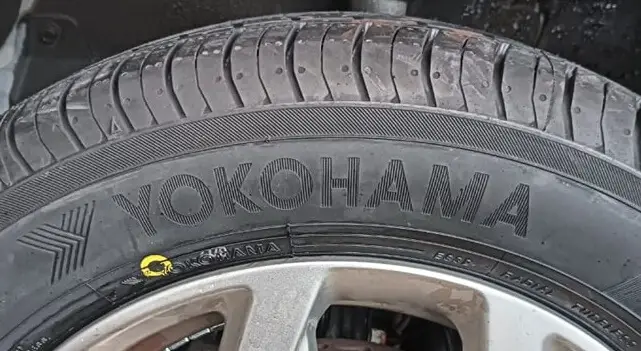
Our Observation
Switching from 175/65r14 to 185/60r14 tires offers a blend of benefits with minimal drawbacks. The wider tires enhance grip and stability, improving on-road handling and potentially off-road traction.
The sportier look is a bonus for those seeking a more aggressive stance. However, the slightly lower profile may marginally reduce ride comfort and off-road durability.
The impact on fuel efficiency and speedometer accuracy is negligible for most drivers. Overall, this tire switch provides a balanced upgrade, enhancing performance without significant compromises in comfort or functionality for both on and off-road use.

Meet Caitlin McCormack, a Tire Size Expert and Blogger Passionate About Everything Related to Tires. With Years of Experience in the Tire Industry, Caitlin Has Become an Expert in Tire Sizes and Their Impact on Vehicle Performance.
